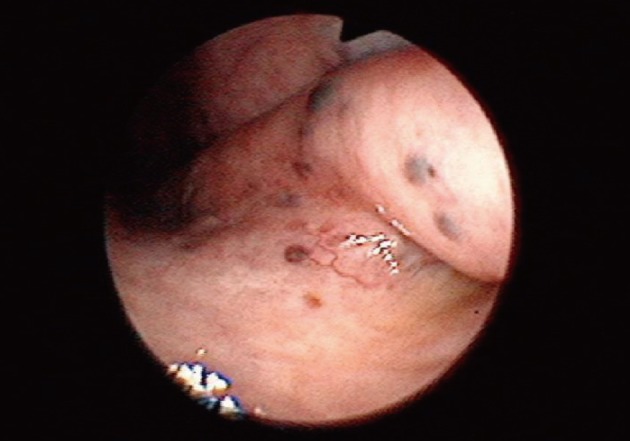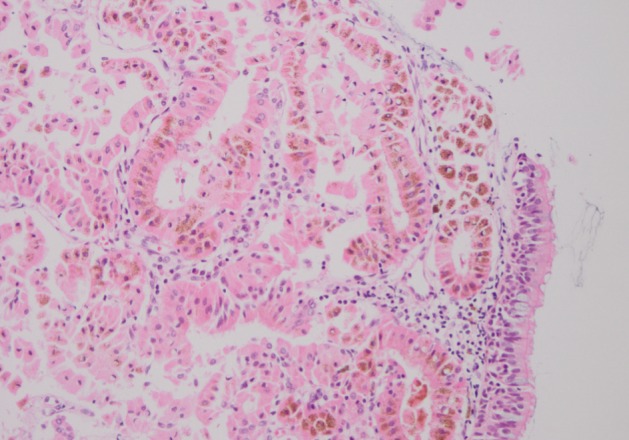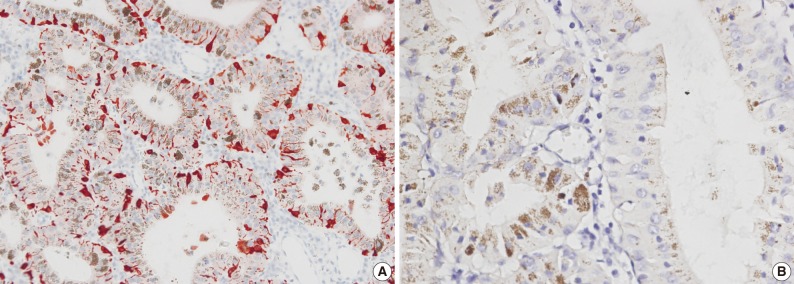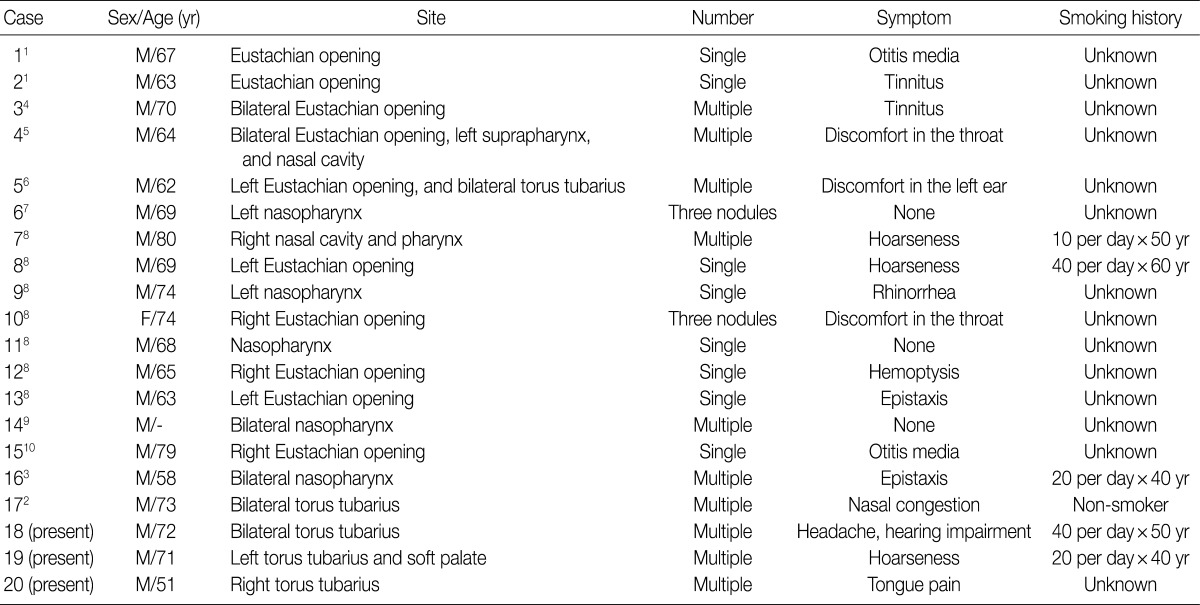Articles
- Page Path
- HOME > J Pathol Transl Med > Volume 46(2); 2012 > Article
-
Case Report
Melanotic Oncocytic Metaplasia of the Nasopharynx: A Report of Three Cases and Review of the Literature - Joo Young Na, Yeong Hui Kim, Yoo Duk Choi, Ji Shin Lee
-
Korean Journal of Pathology 2012;46(2):201-204.
DOI: https://doi.org/10.4132/KoreanJPathol.2012.46.2.201
Published online: April 25, 2012
Department of Pathology, Research Institute of Medical Sciences, Chonnam National University Medical School, Gwangju, Korea.
- Corresponding Author: Ji Shin Lee, M.D. Department of Pathology, Chonnam National University Hwasun Hospital, 322 Seoyang-ro, Hwasun-eup, Hwasun 519-763, Korea. Tel: +82-61-379-7072, Fax: +82-61-379-7099, jshinlee@hanmail.net
• Received: March 8, 2011 • Revised: April 20, 2011 • Accepted: May 4, 2011
© 2012 The Korean Society of Pathologists/The Korean Society for Cytopathology
This is an Open Access article distributed under the terms of the Creative Commons Attribution Non-Commercial License (http://creativecommons.org/licenses/by-nc/3.0) which permits unrestricted non-commercial use, distribution, and reproduction in any medium, provided the original work is properly cited.
Abstract
- Melanotic oncocytic metaplasia of the nasopharynx is a rare condition which is characterized by the presence of usually a small, brown to black colored pigmented lesion around the Eustachian tube opening. Although it is a benign lesion, it may be clinically misdiagnosed as malignant melanoma. Microscopically, melanotic oncocytic metaplasia is a combination of oncocytic metaplasia of the epithelium of the gland and melanin pigmentation in its cytoplasm. In our present study, we report three cases of melanotic oncocytic metaplasia of the nasopharynx. All the three cases occurred in men and were presented as multiple black pigmented lesions around the torus tubarius. Microscopically, mucous glands with diffuse oncocytic metaplasia and numerous black pigments were observed. No cellular atypia was observed. Immunohistochemically, the scattering of S-100 protein-positive, and human melanoma black 45-negative dendritic melanocytes was evident. This is the first report of cases of melanotic oncocytic metaplasia of the nasopharynx in Korea.
- Case 1
- A 72-year-old man presented with a 3-month history of headache and mild hearing impairment. His family and past medical history were unremarkable except for a smoking history of 40 cigarettes per day for the past 50 years. To evaluate the symptoms, a nasoscopic examination was carried out. Nasoscopic examination revealed the presence of multiple dark blue colored mucosal lesions around the bilateral torus tubarius (Fig. 1). Clinician's impression about the lesions was that of melanotic dysplasia. The lesions were biopsied to establish the definitive diagnosis. Follow-up for three months after diagnosis was uneventful, but the lesions remained unchanged.
- Case 2
- A 71-year-old man presented with a 1-day history of hoarseness. His past history was unremarkable but, he had a smoking history of 20 cigarettes per day for the past 40 years. Macroscopically, multiple black mucosal lesions around the left torus tubarius and soft palate were apparent. Clinician's impression of the lesion was that of a nasopharyngeal pigmented lesion. Biopsy was done for establishing the definitive diagnosis. After the biopsy, there was some relief from hoarseness, but at the six-month follow-up, the condition of the lesions remained unchanged.
- Case 3
- A 51-year-old man presented with a 3-month history of tongue pain. He had type C hepatitis but his other past medical history was unremarkable and smoking history was unknown. Nasoscopy was carried out and multiple, dark colored spots around the right torus tubarius were noted. Clinician's impression of the lesion was that of melanotic oncocytic metaplasia of the nasopharynx. Biopsy was performed, but the symptoms persisted. The contact with the patient was lost and hence follow-up after two months was not feasible in the third case.
- The clinical information about each patient is summarized in the Table 1 below.
- Pathological findings
- The histology of all the three cases was similar. Microscopically, the lesions were well circumscribed, but were not encapsulated. In case 1, the surface of the lesion was covered by normal respiratory epithelium. All the three lesions were composed of mucous glands with diffuse oncocytic metaplasia. Oncocytes comprised of abundant eosinophilc granular cytoplasm. Brown pigments were also observed in the cytoplasm of most of the oncocytic cells (Fig. 2). The brown pigments stained positive for Fontana-Masson staining and negative for Berlin blue staining, which were indicative of melanin pigmentation. Mitotic figures or atypia were not observed in the epithelial cells of the gland. Upon immunohistochemical study, dendritic cells in the basal layer of glands were found to be positive for S-100 protein (1:1,000, Dako, Glostrup, Denmark), but were negative for human melanoma black-45 (HMB-45; 1:200, Dako, Carpinteria, CA, USA) (Fig. 3). Based on the above findings, all the lesions were diagnosed as melanotic oncocytic metaplasia of the nasopharynx.
CASE REPORTS
- We have described three cases of melanotic oncocytic metaplasia of the nasopharynx. Till date, only 17 cases of melanotic oncocytic metaplasia of the nasopharynx have been reported in the English literature.1-10 Melanotic oncocytic metaplasia of the nasopharynx predominantly occurred in males (16/17), with an average age of 68 years (range, 56 to 80 years).2,3 All the patients were identified to be of Asian origin. Clinically, the diagnosis was incidental in majority of cases, but some melanotic oncocytic metaplasia of the nasopharynx may occasionally cause symptoms such as otitis media, tinnitus, hoarseness, rhinorrhea, epistaxis, discomfort of the throat, and hemoptysis. These symptoms may be due to the obstruction of the Eustachian tube opening. However, some of the symptoms were thought to be unrelated with the lesions. Macroscopically, all the lesions were a few millimeters in size, single or multiple, and brown to black in color. Bilateral lesions were also seen sometimes (6/17). Clinician's impression of the lesion ranged from a malignant tumor, such as melanoma or carcinoma, to a benign melanocytic nevus. All the reported cases pursued a benign clinical course.3 Till date, there has been no case of disease recurrence or progression in the cases. Simple excision is usually a sufficient treatment for melanotic oncocytic metaplasia of the nasopharynx.6
- All our three patients were males, between fifty-one to seventy-two years of age. They complained of headache, mild hearing impairment, hoarseness, and tongue pain. All of them showed multiple black pigmented lesions around the torus tubarius, and one of them had bilateral lesions. After biopsy, symptoms such as mild hearing impairment and hoarseness disappeared in two of the three patients, but it was not clear whether the symptoms were related to the lesions. Moreover, some complaints such as headache and tongue pain remained unchanged and were considered to be unrelated with the lesions.
- Histologically, melanotic oncocytic metaplasia is characterized in terms of coexistence of oncocytic metaplasia and melanin pigmentation in the same gland. Oncocytic metaplasia is most commonly encountered in certain epithelial organs such as the salivary glands, the lacrimal glands, and the thyroid glands. However, occurrence of oncocytic metaplasia in the upper respiratory tract is an uncommon finding. The origin of the melanin pigment in the oncocytic glands is still unclear. Melanocytes as a melanin source, have been reported to exist in the stroma and epithelium of the nasal cavity, paranasal sinus, and larynx.11 The melanin pigment in the oncocytic glands may be derived from the adjacent melanocytes through their dendrites.5 This hypothesis is supported by the immunohistochemical findings of our three cases. There was the presence of numerous S-100-positive, and HMB-45-negative melanocytes with dendritic processes stretching between the epithelial cells of the glands. Dong et al.12 found Platts bacilli and Cryptococcus neoformans in the nasopharyngeal secretions of patients with melanotic oncocytic metaplasia. As these two types of bacteria can produce melanin, they suggested that the nasopharynx bacteria produced melanin, which was phagocytosed by oncocytes, leading to the formation of melanin containing oncocytes.
- The exact pathogenesis of melanotic oncocytic metaplasia of the nasopharynx is still unknown. However, Sakaki et al.8 postulated that this lesion could be related to the age, smoking, ethnic, and neuro-immuno-endocrine network of the subject. Moreover, in some cases, stimulation by factors such as smoking may play a role in progression of melanotic oncocytic metaplasia. Neuropeptides may cause the oncocytic metaplasia or melanocyte to proliferate and produce melanin through neuro-immuno-endocrine network. Two of our three patients had a smoking history of 40 cigarettes per day from the past 50 years and 20 cigarettes per day from the past 40 years, respectively. However, smoking history in the third patient was not studied. Therefore, in further studies, it is important to clarify the pathogenesis and histogenesis of melanotic oncocytic metaplasia of the nasopharynx.
- In summary, we have described three cases of melanotic oncocytic metaplasia of the nasopharynx with review of relevant literature. Although this is a rare clinical and pathological entity, it is not so difficult for the pathologists and clinicians to make the diagnosis if they have had some experience in handling such cases. The recognition of this lesion is clinically important, since it might be misdiagnosed as a malignancy, such as malignant melanoma by the unwary.
DISCUSSION
- 1. Shek TW, Luk IS, Nicholls JM, Fok KO. Melanotic oncocytic metaplasia of the nasopharynx. Histopathology 1995; 26: 273-275. ArticlePubMed
- 2. Kondo T, Mori K, Oka S, Morinaka S. Melanotic oncocytic metaplasia of the nasopharynx as a benign mimicker of malignant melanoma: a case report. Diagn Pathol 2010; 5: 5.ArticlePubMedPMCPDF
- 3. Li Y, Lu ZH, Lü W, Chen J. Images for diagnosis. Melanotic oncocytic metaplasia of nasopharynx: a case report with review. Chin Med J (Engl) 2010; 123: 1230-1232. PubMed
- 4. Xue WC, Hui YZ. Melanotic oncocytic metaplasia of the nasopharynx. Histopathology 1999; 35: 481-482. ArticlePubMedPDF
- 5. Hirakawa E, Miki H, Ohmori M, Kobayashi S, Haba R, Nagai Y. Melanin pigmented oncocytic metaplasia of the nasopharynx. Virchows Arch 1999; 434: 455-457. ArticlePubMedPDF
- 6. Takano K, Sato J, Shirasaki H, Yamazaki N, Hoki K, Himi T. Melanin pigmented oncocytic metaplasia of the nasopharynx. Auris Nasus Larynx 2004; 31: 161-163. ArticlePubMed
- 7. Kurihara K, Nakagawa K. Pigmented variant of benign oncocytic lesion of the pharynx. Pathol Int 1997; 47: 315-317. ArticlePubMed
- 8. Sakaki M, Shek TW, Hirokawa M, et al. Melanotic oncocytic metaplasia of the nasopharynx: a report of seven cases and review of the literature. Virchows Arch 2004; 444: 345-349. ArticlePubMedPDF
- 9. Liao CT, Kuo TT. Images in pathology: melanotic oncocytic metaplasia of the nasopharynx. Int J Surg Pathol 2005; 13: 279.ArticlePubMedPDF
- 10. Lui PC, Chan AB, Chan KF, Choi CH, Tse GM. Melanocytic and non-melanocytic oncocytic metaplasia of the nasopharynx. Pathology 2004; 36: 504-505. ArticlePubMed
- 11. Uehara T, Matsubara O, Kasuga T. Melanocytes in the nasal cavity and paranasal sinus: incidence and distribution in Japan. Acta Pathol Jpn 1987; 37: 1105-1114. ArticlePubMed
- 12. Dong BC, Tian H, Jia XQ, et al. Melanotic oncocytic metaplasia of the nasopharynx. Zhonghua Er Bi Yan Hou Tou Jing Wai Ke Za Zhi 2005; 40: 549-550. PubMed
REFERENCES
Fig. 1Nasoscopic appearance of melanotic oncocytic metaplasia of the nasopharynx. Multiple, dark blue colored mucosal lesions around the bilateral torus tubarius are noted.


Fig. 2Histological findings of melanotic oncocytic metaplasia of the nasopharynx. The lesion is located in the subepithelial area and consists of mucous glands with diffuse oncocytic metaplasia and numerous brown colored melanin pigments.


Figure & Data
References
Citations
Citations to this article as recorded by 

- A Case of Melanotic Oncocytic Metaplasia of the Nasopharynx
Yurino Nagata, Kazuaki Chikamatsu
Practica Oto-Rhino-Laryngologica.2025; 118(3): 195. CrossRef - Lesions that mimic malignant tumors in nasopharyngeal biopsies: case series of 10 years
Mine Ozsen, Ozlem Saraydaroglu, Selin Yirmibes, H. Hakan Coskun
Tumori Journal.2022; 108(2): 119. CrossRef - Melanotic Oncocytic Metaplasia of the Nasopharynx Seen as a Rare Form
of Cystic Mass: A Case Report and Review of the Literature
Keun-Ik Yi, Yong-Wan Kim
Journal of Clinical Otolaryngology Head and Neck Surgery.2022; 33(1): 23. CrossRef - Melanotic Oncocytic Metaplasia of the Nasopharynx: A Case Report With Review of Literature
Hsing-Yu Chen, Mpendulo Felix Gule, I-Wei Chang
Ear, Nose & Throat Journal.2021; 100(5_suppl): 771S. CrossRef - Malignant Mucosal Melanoma of the Eustachian Tube With Extension Into the Ipsilateral External Ear Canal: A Case Report and Review of the Literature
Lifeng Li, Nyall R. London, Xiaohong Chen
Ear, Nose & Throat Journal.2021; 100(5_suppl): 730S. CrossRef - Melanotic oncocytic metaplasia of the nasopharynx: A case report discussing the pathogenesis of a lesion
Shina Sakaguchi, Hiromasa Takakura, Shin-ichi Hayashi, Akira Noguchi, Hirohiko Tachino, Hideo Shojaku, Johji Imura
Otolaryngology Case Reports.2021; 20: 100276. CrossRef - Oncocytic Cysts of the Nasopharynx: A Case Report
Joshua C. Hwang, Raj D. Dedhia, Joan E. Bernard, Toby O. Steele
Allergy & Rhinology.2020; 11: 215265672095659. CrossRef - Melanotic Oncocytic Metaplasia of the Nasopharynx in the Patient with Suspicious Hemoptysis: Case Report
Taek Yoon Cheong, Han Seong Kim, Ick Soo Choi
Journal of Rhinology.2020; 27(2): 140. CrossRef - Clinicopathological features of melanotic and non-melanotic oncocytic lesions of the nasopharynx
Joshua J.X. Li, Joanna K.M. Ng, Amy B.W. Chan
Pathology.2019; 51(6): 600. CrossRef - Melanotic oncocytic metaplasia of the nasopharynx
Keiichiro Uehara, Yu Usami, Yukihiro Imai, Michio Shimizu
Pathology International.2015; 65(3): 144. CrossRef
Melanotic Oncocytic Metaplasia of the Nasopharynx: A Report of Three Cases and Review of the Literature



Fig. 1 Nasoscopic appearance of melanotic oncocytic metaplasia of the nasopharynx. Multiple, dark blue colored mucosal lesions around the bilateral torus tubarius are noted.
Fig. 2 Histological findings of melanotic oncocytic metaplasia of the nasopharynx. The lesion is located in the subepithelial area and consists of mucous glands with diffuse oncocytic metaplasia and numerous brown colored melanin pigments.
Fig. 3 Immunohistochemical staining of melanotic oncocytic metaplasia. Dendritic melanocytes, which are positive for S-100 (A), but are negative for human melanoma black-45 (B), are interspersed among the pigmented oncocytic cells.
Fig. 1
Fig. 2
Fig. 3
Melanotic Oncocytic Metaplasia of the Nasopharynx: A Report of Three Cases and Review of the Literature

Table 1 Clinical findings of cases with melanotic oncocytic metaplasia of the nasopharynx
M, male; F, female.

 E-submission
E-submission


 PubReader
PubReader Cite this Article
Cite this Article




